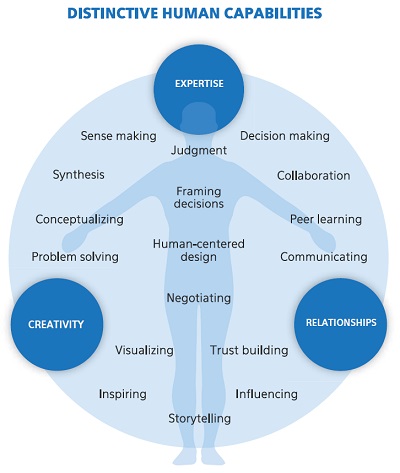Redefining distinctive human capabilities with the advent of generative AI
What are our distinctive human capabilities, the ones that distinguish us from machines for the longest?
I believe that is perhaps the single most important question we face. If we understand that we can redesign work, focus on developing our unique capabilities, and best complement ourselves with machines.
 In 2016 as part of my Humans in the Future of Work diagram I framed these as Expertise, Creativity and Relationships, and every way they can be combined.
In 2016 as part of my Humans in the Future of Work diagram I framed these as Expertise, Creativity and Relationships, and every way they can be combined.
With the leap in capabilities of generative AI, it is time for me to come back to rethink and reconsider this framing.
I’d love to get your thoughts as I rework this.
Of course any framework is a simplification, and perhaps a next iteration of this should be more nuanced, though it needs to start with the highest-order concepts.
What I meant by Expertise is a deep understanding of a domain, having the fullest context and richest mental models to best direct action and predict outcomes. Despite the surprising leap in AI abilities at pretending expertise, I believe this will remain a distinctive human capability. However perhaps the concept or language needs to be made more precise to distinguish what humans excel at.
Machines can now demonstrate Creativity to the degree that we can say it is no longer a uniquely human domain. We can argue about the nature and value of machine creativity, but it creates, it is literally generative.
I went to a youth art exhibition on Sunday, and was staggered at not just the talent, but the depth of emotion and even wisdom reflected in the works. There is creativity based on feeling and there is ersatz creativity. We will always value artists, and we will always value human creativity.
Yet there is something more specific in the distinction between machine and human creativity that I want to define.
Relationships are more obviously still a distinctive human ability. It is true that machines can evoke emotion, display apparent affect, and give a sense of companionship. There is no question that an increasing number of people will fall in love with AI and robots. Yet only humans can truly empathize with others, which gives the immense power of inspiration.
In Thriving on Overload I pointed to Synthesis as the “ultimate human capability”. I stand by that as a key element, and will share more on that soon.
Another reframing of Creativity is Innovation, which could be seen as including the creation of new technologies. Perhaps not unique to humans, but still highly distinctive.
In my Mapping Intelligence framework I identified 6 dimensions to intelligence across humans and machines: Goal orientation, Problem solving, Sense making, Freedom, Learning, and Adaptation. From these Sense making and Freedom are the most obviously distinctively human.
What I have been thinking the most about lately is Intent. Humans are the only ones who have intentions, and machines should only enact those intentions. If they have intentions and they are not fully aligned with ours, then we have a problem.
There are other dimensions I am exploring, these are just top-of-mind thoughts for now. Please let me know any input you have!
Image: Zoltan Tasi



